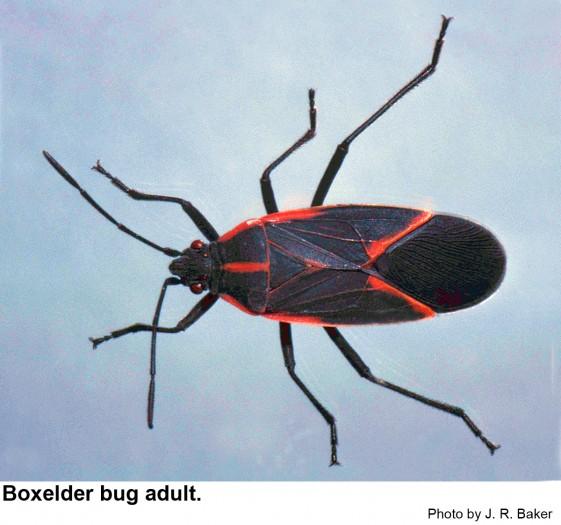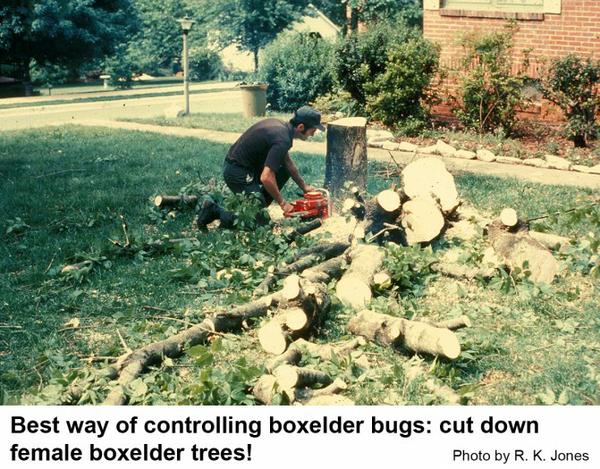Description and Biology
Boxelder bugs, Boisea (Leptocoris) trivittata, are dark gray to black with three red stripes on the thorax. They are about a half inch long. The leathery parts of the wings are outlined in red, and the eyes are also red. Females lay eggs that are light yellow but soon darken to rusty red. Nymphs are conspicuously bright red, although older nymphs have dark gray wing pads. The head, legs and antennae are gray. Adult boxelder bugs emerge from their overwintering shelters in March and early April and feed for about 2 weeks before mating. These insects prefer sunny areas and, therefore, are found most abundantly on trees in a southern exposure and on sides of buildings facing south. Eggs are deposited in masses of 10 or 11 eggs usually in bark crevices. Each female deposits a total of about 230 eggs. The eggs hatch in about 2 weeks. Development of the six nymphal stages takes 50 to 70 days. The boxelder bug population increases rapidly from middle July to early September. Two generations are produced each year. The insects seek overwintering places in September and October. Only the adults survive the winter as boxelder bugs have the socially unacceptable habit of dining on any nymphs unfortunate enough to be in the vicinity. Because these insects feed primarily on boxelder and maple seeds, after the seeds drop boxelder bugs are sometimes found on the ground feeding on fallen seeds. As boxelders produce their seeds, the bugs move up to feed in the tree.
Host Plants
Boxelder bugs feed on the seeds of boxelder trees and to a lesser extent on the seeds of maples and ash trees. Sometimes these bugs can become quite abundant on maples or ash trees. However, when people are bothered by boxelder bugs year after year it is usually because a female boxelder tree is in the yard or nearby. Although boxelder bugs are associated with shade trees, this insect can become a household pest as well. In fall, boxelder bugs tend to congregate on buildings and enter cracks and crevices to overwinter. They usually do not bite people or harm goods, but their presence is a nuisance. On warm winter days, the insects become active and move about in and on buildings where they cause concern for the occupants.
Residential Recommendation
Sometimes boxelder bugs become such a nuisance that the only solution seems to be to cut down the female boxelder trees in the yard. Boxelder bugs noticed in late spring or summer are much more susceptible to pesticides than later in the fall when they start invading houses. When the weather is cool and they are ready to hibernate, boxelder bugs are much more tolerant of pesticides. If boxelder bugs are vacuumed up, empty the vacuum soon to prevent the bugs from creating a foul odor inside as they die and decay.
References
- Boxelder Bug Household Pests. Walvogel, M. G. and S. B. Bambara. 2005. NC State Extension Publications
- Boxelder bugs. Scott, J. M. 2010. Home & Garden Information Center, Clemson Coop. Extension. HGIC 2409.
- Extension Plant Pathology Publications and Factsheets
- Horticultural Science Publications
- North Carolina Agricultural Chemicals Manual
For assistance with a specific problem, contact your local N.C. Cooperative Extension Center
This Factsheet has not been peer reviewed.
Publication date: Oct. 5, 2013
Reviewed/Revised: Sept. 11, 2019
The use of brand names in this publication does not imply endorsement by NC State University or N.C. A&T State University of the products or services named nor discrimination against similar products or services not mentioned.
N.C. Cooperative Extension prohibits discrimination and harassment regardless of age, color, disability, family and marital status, gender identity, national origin, political beliefs, race, religion, sex (including pregnancy), sexual orientation and veteran status.



